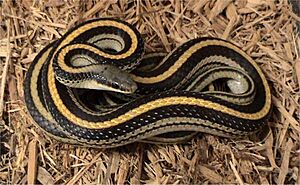Salvadora grahamiae facts for kids
Quick facts for kids Salvadora grahamiae |
|
|---|---|
 |
|
| Conservation status | |
| Scientific classification | |
| Genus: |
Salvadora (snake)
|
| Species: |
grahamiae
|
| Synonyms | |
|
|
The eastern patch-nosed snake (also called the mountain patchnose snake) is a type of snake known scientifically as Salvadora grahamiae. It belongs to a large family of snakes called Colubridae. You can find this snake living in the southwestern United States and nearby parts of northeastern Mexico.
Contents
Where Does Its Name Come From?
The scientific name for this snake, grahamiae, was given to honor a person. It's named after Colonel James Duncan Graham. He was a military engineer in the United States Army.
Where These Snakes Live
The eastern patch-nosed snake lives in several places. In the United States, you can find it in Arizona, New Mexico, and Texas. It also lives in Mexico, in the states of Chihuahua, Coahuila, Querétaro, Tamaulipas, and Veracruz.
Their Homes and Habitats
These snakes are very adaptable and can live in many different environments. They are found in forests, open savannas, and areas with lots of shrubland. You might also see them in grasslands and even dry deserts. They can live from sea level up to about 6,500 feet (1,980 meters) high.
What They Look Like
The eastern patch-nosed snake can grow to be about 47 inches (119 centimeters) long, including its tail. It has a special scale on its snout that looks like a patch, which gives it its common name.
What They Eat
This snake is a predator, which means it hunts other animals for food. It mostly eats lizards, especially those from the Aspidoscelis group. They also enjoy eating reptile eggs and small snakes. Sometimes, they will eat baby birds that are still in their nests or small mammals.
Reproduction and Life Cycle
The eastern patch-nosed snake reproduces by laying eggs. This is called being oviparous. The female snakes usually lay their eggs between April and June. A single group of eggs, called a clutch, typically has 5 to 10 eggs.


